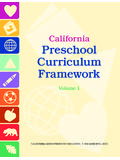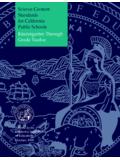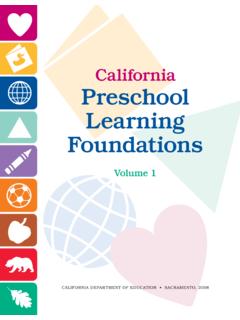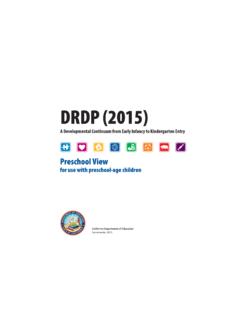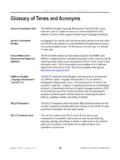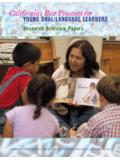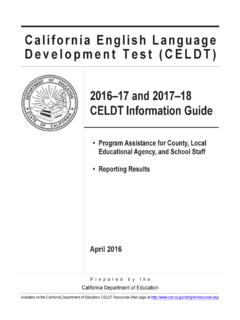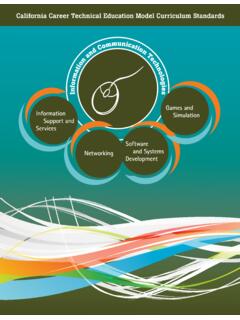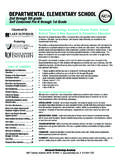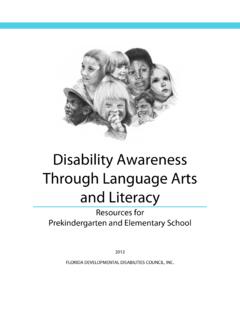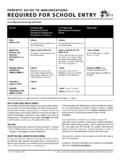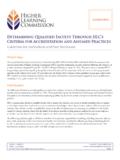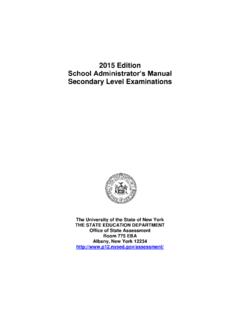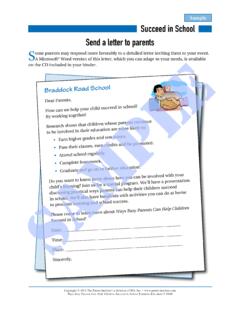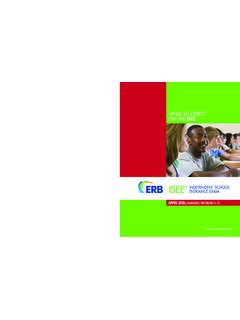Transcription of Model School Library Standards for California Public ...
1 Model School Library Standards for California Public Schools Kindergarten through Grade Twelve Adopted by the California State Board of Education September 2010 Model School Library Standards for California Public Schools Kindergarten through Grade Twelve Publishing InformationWhen Model School Library Standards for California Public Schools, Kindergarten through Grade Twelve was adopted by the California State Board of Education on September 16, 2010, the members of the State Board were the following: Theodore Mitchell, President; Ruth Bloom, Vice President; Alan Arkatov; James Aschwanden; Benjamin Austin; Yvonne Chan; James Fang; Gregory Jones; David Lopez; Johnathan Xavier Williams; and Connor Cushman, Student Member. This publication was edited by Faye Ong. It was designed and prepared for printing by the staff of CDE Press, with the cover and interior design created and prepared by Cheryl McDonald.
2 It was published by the California Department of Education, 1430 N Street, Sacramento, CA 95814-5901. It was distributed under the provisions of the Library Distribution Act and Government Code Section 11096. 2011 by the California Department of EducationAll rights reserved ISBN 978-0-8011-1710-7 Reproduction of this document, in whole or in part, for resale is not authorized. Special Acknowledgments The State Board of Education extends its appreciation to those who contributed to the development and review of the Model School Library Standards for California Public Schools, Kindergarten through Grade Twelve under the provisions of California Education Code Section 18101. Special appreciation is extended to Jack O Connell, State Superintendent of Public Instruction, under whose leadership the project was developed; the California School Library Association; representatives from California teacher librarian credential programs; technology and Library representatives from districts and county offices of education.
3 And the volunteer writing team, which included the following people: Doug Achterman, San Benito High School DistrictRosemarie Bernier, Los Angeles Unified School District Lesley Farmer, California State University, Long Beach Anna Koval, Petaluma City Elementary School DistrictPamela Oehlman, Long Beach Unified School DistrictTanya Richards, Modesto City SchoolsMartha Rowland, Sacramento City Unified School DistrictDana Stemig, Modesto City SchoolsGlen Warren, Orange County Office of EducationCarolyn Williams, Alvord Unified School District Connie Williams, Petaluma City Elementary School District Appreciation is also extended to the California School Library Association; California Office of Privacy Protection; California State PTA; California Teachers Association; Common Sense Media; Computer-Using Educators, Inc.; Internet Keep Safe Coalition; Librarians Association of the University of California ; Web Wise Kids; and the governing boards of Berkeley Unified School District and Long Beach Unified School District.
4 Special commendation is extended to Thomas Adams, Director, Standards , Curriculum Frameworks, and Instructional Resources Division; Susan Martimo, Administrator, Curriculum Frameworks Office; Cynthia Gunderson, Acting Manager, Curriculum Frameworks Office; and Barbara Jeffus, School Library Consultant. Their significant contributions to this document deserve special recognition. Ordering Information Copies of Model School Library Standards for California Public Schools, Kindergarten through Grade Twelve are available for purchase from the California Department of Education. For prices and ordering information, please visit the Department Web site at or call the CDE Press Sales Office at 1-800-995-4099. Notice The guidance in Model School Library Standards for California Public Schools, Kindergarten through Grade Twelve is not binding on local educational agencies or other entities. Except for the statutes, regulations, and court decisions that are referenced herein, the document is exemplary, and compliance with it is not mandatory.
5 (See California Education Code Section ) Contents A Message from the State Board of Education and the State Superintendent of Public Introduction ..vi School Library Standards for Students .. viii Kindergarten ..1 Grade One ..4 Grade Grade Three ..10 Grade Four ..13 Grade Grade Six ..19 Grades Seven and Grades Nine through School Library Program Standards ..31 Bibliography ..35 iii A Message from the State Board of Education and the State Superintendent of Public Instruction The Model School Library Standards forCalifornia Public Schools, Kindergarten through Grade Twelve sets a groundbreaking vision for strong School Library programs in California , including identification of the skills andknowledge essential for students to beinformation literate. In today s world, thatterm means having the skills to effectively access, evaluate, use, and integrate informa-tion into their lives.
6 The new, rigorous School Library Standards are designed to help stu-dents prepare for success in the hypercom-petitive global economy that is powered by information and knowledge. These Standards will help students to learn and work withtwenty-first century skills and apply respon-sible research practices, be respectful to oth-ers when using digital devices, and continueto grow as lifelong learners. The Standards also describe recommended baseline staffing, access, and resources for School Library ser-vices needed by students to meet academicstandards. The School Library Standards maintain California s respect for local control of schools. They provide guidance to School districts for implementing strong School Library programs. Such Library programs improve student achievement, foster literacy, produce a technology-competent workforce, and nurture lifelong learning. We encourage local decision makers and educators to use these Standards to design Library policies and curricular and instructional strategies that best deliver content to their students.
7 The School Library Standards reflect our commit-ment to excellence in School Library servicesthroughout the state. Michael Kirst President California State Board of Education toM torlaKson State Superintendent of Public Instruction California Department of Education v vi Introduction More than 60 research studies throughout the nation, from Alaska to North Carolina to California , have shown that students in schools with good School libraries learnmore, get better grades, and score higher on standardized tests than their peers in schools without libraries. Douglas Achterman s 2008 doctoral disser-tation on student achievement in California , titled Haves, Halves and Have-Nots: School Libraries and Student Achievement, found that the greater the number of Library services offered, the higher students scores tended to be. On the History test, the libraryprogram is a better predictor of scores than both School variables and community vari-ables, including parent education, poverty, ethnicity, and percentage of English language learners.
8 1 Examining 60 Southern California schools,Lesley Farmer studied the possible factorscorrelating student academic achievement and School Library programs. The study results identified key indicators in the Library program that impact student academic achievement: access to high-quality libraryresources and facilities and collaborative planning with professional Library In their joint doctoral dissertation UsingLarge-Scale Assessments to Evaluate the 1. Douglas Achterman, Haves, Halves and Have-Nots: School Libraries and Student Achievement (PhD diss., University of North Texas, 2008). 2. Lesley Farmer, Degree of Implementation of Library Media Programs and Student Achievement, Journal of Librarianship and Information Science 38 (March 2006): 21 32. Effectiveness of School Library Programs in California , Stacy Sinclair-Tarr and William Tarr found statistically significant positive relationships between the presence of School Library programs and student achievement on both the English language arts and math-ematics California Standards Tests at the elementary and middle School The California Education Code (EC) rein-forces the integral role of School libraries by requiring School districts to provide School Library services and the State Board of Edu-cation to adopt Standards , rules, and regula-tions for School libraries.
9 The relevant EC sections are as follows: Section 18100. The governing board of each School district shall provide School Library services for the pupils and teachers of thedistrict by establishing and maintainingschool libraries or by contractual arrange-ments with another Public agency. Section 18101. The State Board of Education shall adopt Standards , rules and regulations for School Library services. School libraries have evolved from sim-ply providing print materials to offering rich selections of print, media, and digitalresources; from teaching students how to search a card catalog to teaching students strategies for searching a variety of print, media, and digital resources; from teaching 3. Stacy Sinclair-Tarr and William Tarr, Jr., Using Large-ScaleAssessments to Evaluate the Effectiveness of School Library Programs in California , Phi Delta Kappan 88, no. 9 (May 2007): 710 11. introduction basic reading literacy to teaching informa-tion literacy (the ability to access, evaluate,use, and integrate information and ideaseffectively).
10 However, the skills learned from print transcend their use in books alone. Students who understand systems of textorganization are better equipped to use the Internet as it is today. Most notably, they expect worthy resources to have order. This may drive them to probe complex web sites, which, for all their bells and whistles, are fundamentally arranged like reference books, with A Z lists and topical Two types of Standards are provided: School Library Standards for delineate what students should4. Nancy R. Preston, A is for Einstein: The Alphabet Versus the Internet, Phi Delta Kappan 91, no. 1 (September 2009): 80. know and be able to do at each gradelevel or grade span to enable studentsto succeed in School , higher education,and the workforce. School Library Program describe base-level staffing,resources, and infrastructure, includingtechnology, required for School libraryprograms to be effective and helpstudents to meet the School Library Standards provide guidance to School districts striving to improve their School Library programs and raise student achievement.
